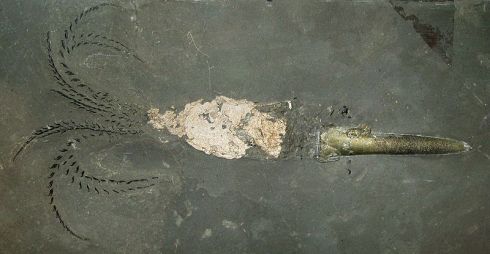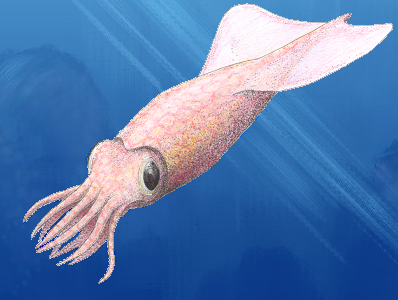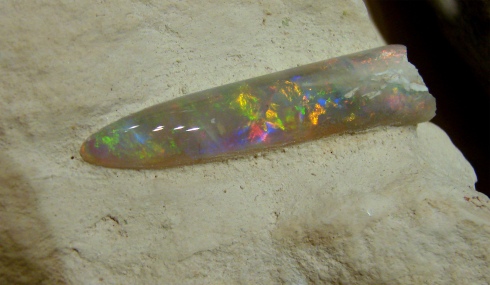This blog has already traveled back 400+ million years to the Ordovician, the era when great mollusks ruled earth’s oceans. The Ordovician ended in ice as Gondwanaland drifted into the Southern Polar regions—a tectonic shift which brought massive terminal cooling to the great reef systems of the time (and also fundamentally changed Earth’s climate and atmosphere), but the cephalopods were hardly done for. They continued to evolve and adapt to the world’s ever changing oceans. Today we pick up the cephalopod story hundreds of millions of years later during the Mesozoic era—the time of dinosaurs.
The reefs and oceans of the Jurassic and Cretaceous were filled with nautiloid cephalopods—ram shelled descendants of the shelled tentacled monstrosities from the Ordovician—but a new cephalopod had also evolved and filled up the shallow limestone seas in giant teaming schools. These were the belemnites which lacked an external shell and superficially resembled squid.
Belemnites were distinct from today’s squids for several reasons. Not only did they possess hard internal shells/skeletons composed of calcium carbonate but they also lacked the pair of specialized hunting tentacles present in modern cuttlefish and squid. Instead the belemnites hunted with ten arms covered in tiny wicked hooks.

An Amzaingly well preserved fossil belemnite from the 155 million year old Jurassic Solnhofen limestones in Germany (notice the details of the animal's soft anatomy)
Belemnites fed on ostracods, crustaceans, and fish. In turn they made up a sizeable portion of diet for, well, the sizeable predators of the time. Fossils of plesiosaurs, pliosaurs, and giant sharks have been discovered with stomachs full of hooks or rostra. It is also thought that the dolphin-like ichthyosaurs survived largely on belemnites. After feeding and digesting the mollusks, the ichthyosaurs probably vomited out the indigestible hooks and rostra of belemnites much in the manner that sperm whales expel the hooks of giant squid!
The bullet shaped rostra of belemnites have survived in vast numbers and are one of the most characteristic of all Mesozoic fossils. These strange tapered cones weathered out of soft chalks nearly intact and proved extremely puzzling to people of past generations. Numerous magical common names and magical folk beliefs grew out of the conical rocks. The English called the fossils “thunderbolts” and believed they were the physical leftovers from lightning strikes. The ancient Scandinavians thought that belemnite rostra were candles dropped by gnomes, elves, and dwarves on the occasions they traveled from their realms through this world. The ancient Chinese called them “sword stones” and believed they were imbued with ancient healing magic.
The end of belemnites was even more astonishing than these myths. The creatures had short lives—which involved a larval phase drifting amidst the microscopic plankton. The immense extraterrestrial bolide which struck the Earth at the end of the Cretaceous ended the dinosaurs and also finished off the belemnites. The little larvae were unable to survive the massive planktonic die-off which accompanied the long dark winter following the strike. Fortunately other cephalopods proved hardier–and the most intelligent mollusks continued to change and adapt right up until today.






2 comments
Comments feed for this article
March 5, 2012 at 9:33 PM
Diana
Those fossils are amazing! So cool.
March 7, 2012 at 4:54 PM
Wayne
The opalized fossil is a particular marvel, but belemnite fossils which have been more conventionally mineralized are also really fascinating.